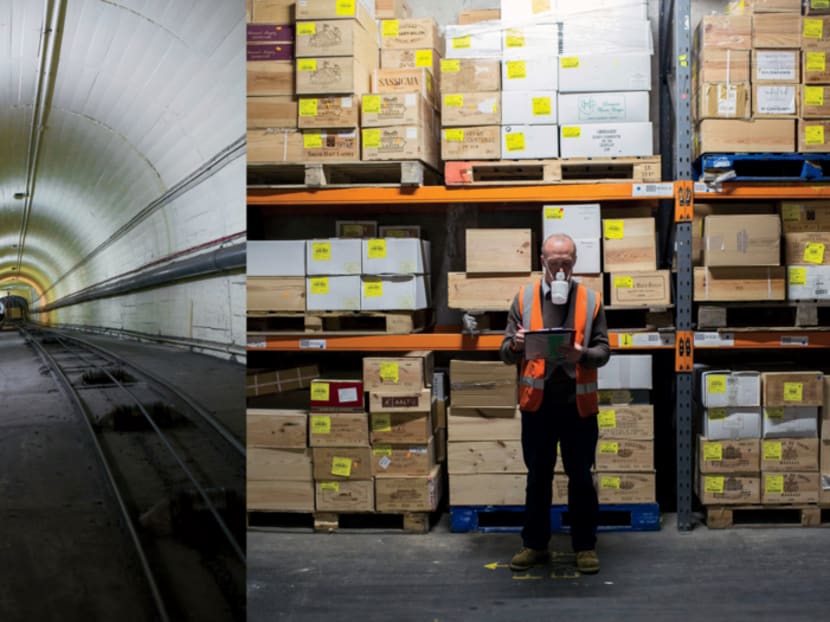Collectors stash S$2.1 billion of wine in old British ammo dump
LONDON — You’d never know it was there. Past a field dotted with hay bales, my driver turns up a small road that seems to go nowhere. When we reach a metal gate, a security guard comes out to greet me. Then he hands me a gas mask that looks like it should be in a war museum.

In recent years, once-soaring prices of investment-grade vintages have slowed, but that hasn’t hurt Octavian: The wine is staying underground longer as clients wait for another surge. Photo: Bloomberg
LONDON — You’d never know it was there. Past a field dotted with hay bales, my driver turns up a small road that seems to go nowhere. When we reach a metal gate, a security guard comes out to greet me. Then he hands me a gas mask that looks like it should be in a war museum.
That’s not as crazy as it sounds.
I’m about to go 30m below rolling farmland outside Bath, England, to see more than £1 billion (S$2.15 billion) worth of fine wine stored in an old mine that during World War II was a munitions dump. It’s been stashed there by clients ranging from Christie’s and Sotheby’s to financier Guy Hands.
At 93,000sqm — think 22 football fields — Octavian’s Corsham Cellars is one of the largest storage facilities for fine wine in Europe. In the 1800s, it was an underground quarry that produced the honey-coloured stone used to build the grand homes in nearby Bath. In the late 1930s, the UK Ministry of Defence took it over. Twenty-five years ago, it was turned into a wine vault, but technically it remains a mine, hence the gas mask requirement.
Above ground, behind a security hut, a blue sign is emblazoned with Octavian’s logo: “Our world is fine wine”. From inside a non-descript green warehouse, a tiny industrial train transports the cosseted wine to the vaults, but the only way in for mere mortals is to walk 157 steps down a dimly lit mine shaft.
As we descend, I’m hit by cool, humid air, a first hint of the care taken with the wine. In the vaults, the temperature is naturally about 13 degrees Celsius, the ideal temperature for storing wine. Humidity is kept at 80 per cent, plus or minus 5, and checked hourly. Filters cover light fixtures to reduce damage from ultraviolet radiation. There are motion detectors at the mine entrance; it would require an Ocean’s Eleven’s type operation for thieves to haul anything out of here.
Wooden cases of awe-inspiring wine — a 1996 Chateau Latour here, a 2008 Chateau Lafite Rothschild there — are stacked high. Mr Vincent O’Brien, the Irish-born Octavian managing director who’s my guide, says staff stood in amazement when a case of 1945 Chateau Lafite arrived earlier this year. Somewhere down here, dispersed among different chambers to reduce risk, are 1,000 cases or bottles dating from 1775 to 1800. “Are you getting the feeling we’re full?” Mr O’Brien, 45, asks.
Almost. The number of cases stored by Octavian has swelled 35 per cent during the past four years. In the wake of the financial crisis, wine investing became de rigueur as money rushed toward alternative assets. Standout Bordeaux vintages from 2009 and 2010 sent wine investors into a tizzy. Until 2011, 95 per cent of the stored wine was from Bordeaux. Since the Bordeaux bull market ended in 2011, the Liv-ex Fine Wine 100 Index, which tracks prices for the 100 most sought-after wines, has fallen by about a third’and so has appetite for Bordeaux.
But that hasn’t hurt Octavian. Investors such as Hands are sitting on their collections. Mr Hands recalls hauling a 1976 bottle of Salon Le Mesnil Champagne to Whistler, Canada, at Christmas time last year to celebrate the anniversary of meeting his wife at a New Year’s party. Having bought the bottle for £100 in 1999, he made the mistake of looking up the price now: £1,800. He ended up taking it back home. “I just thought, I can’t drink it!” he remembers. “It seems slightly sad in a way.”
The average time a case stays underground has increased to eight years, up from about six in 2011. Local residents shot down plans to build an extra warehouse directly above the mine to deal with increased demand. Instead, Octavian opened a high-tech spillover facility above ground about 8km away in Colerne. At its two locations, Octavian houses £1.5 billion worth of wine, Mr O’Brien says.
These days, clients are demanding photographs to document labels and the condition of wooden cases. A dent in the wood can lower values as much as 15 per cent, Mr O’Brien says. Octavian is in the process of building a new underground photo studio to churn out 6,000 images a month, up from about 500 in 2012. “We’ve got a different type of customer coming in the last couple of years,” he says. “They’re looking at it more from an investment angle.”
After an hour underground, I ask to be taken to the most expensive case in the vaults. “We’ll take you to the DRCs,” Mr O’Brien says. No, he’s not talking about the Democratic Republic of Congo but Domaine de la Romane-Conti, which produces some of the most expensive Burgundies in the world. “We’ve got a huge collection!” he says. After a half-hour search for a 120,000 case of 1985 DRC, I give up. I’m freezing, and I think I need a drink. BLOOMBERG





